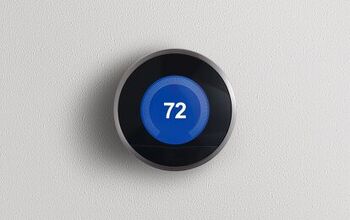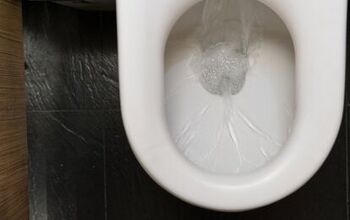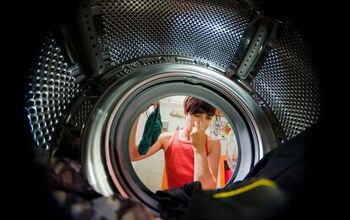Why Does My Thermostat Keep Clicking? (Find Out Now!)

It’s normal for your thermostat to click every time you call for heat (in the winter) or A/C (in the summer). However, if your thermostat is clicking constantly, it’s possible that the thermostat, thermostat wire, or relay connected to your comfort system is beginning to fail.
Before replacing any of these three components, it’s important to understand how they work with each other. Doing so allows you to better identify what’s causing the clicking sound to begin with.
Do You Need Your Thermostat Repaired or Reprogrammed?
Get free, zero-commitment quotes from pro contractors near you.

Why Your Thermostat Clicks
When your thermostat clicks, you hear the electrical contacts within the thermostat completing a circuit. A contact allows a low-voltage electrical current to travel between your heating and/or A/C system and the thermostat. As the current is traveling back to the system, your air handler or boiler gets the OK to start running.
Which components actually cause the clicking sound depends on whether you have a mechanical or digital thermostat.
What Causes The Clicking In A Mechanical Thermostat
A mechanical thermostat contains a bimetal coil that expands and contracts with changes in temperature. This movement causes the contacts within the thermostat to open (terminate the circuit) or close (complete the circuit).
Let’s say you set the temperature in your home to 70 degrees Fahrenheit. It’s in the middle of summer, and the thermostat registers an indoor temperature of 80°. This causes the bimetal coil to expand, pushing the contact toward a magnet which completes a circuit to your A/C unit. There’s the “click.”
If you have an older thermostat, the “clicking” is caused by the electrical contacts on a mercury bulb to fall to one side (heat) or the other (cool). Thermostats possessing temperature dials often have mercury bulbs.
Whether we’re talking about thermostats with magnets or mercury bulbs, there are a lot of moving parts that, while resilient, are prone to failure. These failures can lead to the incessant clicking you’re hearing.
What Causes The Clicking In A Digital Thermostat
Older digital thermostats contain many of the components within their mechanical counterparts. The key difference is that they use a constant flow of electricity to power the display.
For example, if you set the temperature to 70°, and the thermostat senses a temperature lower or higher than the one you’ve specified, the contacts will move accordingly. Again, there’s the click.
Note that many digital thermostats – especially the new ecobees and Nests – don’t have any mechanical components to speak of. Such products have small circuit boards (essentially, tiny computers) to register temperatures and complete electrical signals.
Clicking noises aren’t common in the new-school thermostats, even under normal operating conditions. For example, ecobee’s support team noted that a “clicking” sound may be indicative of a bad C wire, or inadequate voltage between the C and RC terminals. Always refer to the manufacturer’s instructions if attempting to install these thermostats yourself – and keep the paperwork!
What’s Causing The Thermostat To Click Continuously?
Overall, there are four possible reasons why the thermostat won’t stop clicking:
- The mercury bulb has cracked, and is causing the electrical contacts attached to it to malfunction.
- One of the magnets or relays within the thermostat has failed.
- The wire between your thermostat and your heating system is damaged.
- Your heating or cooling system is short-cycling – meaning it’s turning on and off frequently.
Troubleshooting the first and second scenarios is easy in that all you need to do is get a technician to temporarily install a new thermostat and call for heat or A/C. If the clicking ceases, and your home comfort systems respond appropriately, the issue has been resolved.
However, what if you have a damaged thermostat wire? What if your furnace, boiler, or A/C condenser keeps intermittently powering up?
Checking For A Damaged Thermostat Wire
There are a couple of basic hand tools you’ll need to check if the thermostat wire has been damaged:
- A small Phillips-head screwdriver or 11-in-one.
- A dual-range, non-contact voltage tester. If you don’t have one handy, Home Depot and Lowe’s have plenty to choose from. Make sure it can register low-voltage (24 volts).
Once you have these items, you’re ready to diagnose the wire running to your thermostat:
- Remove the thermostat from the wall to expose the circuit board (digital) or subbase (mechanical) of the thermostat itself.
- Use the screwdriver to remove the thermostat wire from the terminals.
- Set your voltage tester to register a low-voltage signal (again, 24 volts or lower) and place it on both the red and white thermostat wires.
- If you come back with no signal, or a signal lower than 24 volts, the thermostat wire is the issue and needs to be replaced.
If the wire needs to be replaced, go to the unit connected to the thermostat you just diagnosed. It will be an air handler if you have central air or a boiler if you have some form of hydronic heat (baseboard, radiators, and so forth).
If you have a boiler, the thermostat should either be connected to a zone valve, or a central relay, depending on the way it was originally set up. In the event you have a furnace and/or air handler, the wire will be connected directly to a circuit board mounted to the unit itself.
At this point, call a technician to figure out the best option for replacing the thermostat wire. Best option, he or she will simply snake a new line along the damaged one and connect it to your thermostat. Test the thermostat again to ensure the clicking has not returned.
Why A Clicking Thermostat May Be Symptomatic Of Short Cycling
As mentioned earlier, short-cycling is a process in which your furnace, boiler, or A/C condenser keeps turning on and off.
Short-cycling may occur for any number of reasons, one of them being where the thermostat is placed in your home. A thermostat may repeatedly close and open if it is placed:
- In a southerly-facing wall that receives direct sunlight constantly.
- Directly over or below a heat register.
- Near a drafty window or door.
- In an outside wall that is either poorly insulated or not insulated at all.
All of these scenarios introduce variability. If your thermostat is placed directly near the entryway to your home, it’s constantly encountering cold gusts of air during the winter. This is especially true if the door isn’t sealed properly.
In a case such as this, the thermostat isn’t failing. It’s calling for heat or cool air like it’s supposed to. The problem is where it was installed in the home.
Even a particularly drafty inside wall can be problematic. If it wasn’t sealed properly during new construction, air may travel between the studs, throwing off the thermostat’s “true” temperature reading.
Video: Top 4 Reasons Why A Gas Furnace Short Cycles
Other Causes Of Short-Cycling
Essentially, a continuously clicking thermostat may be symptomatic of a short-cycling furnace, boiler, or condenser. What’s causing the short-cycling to begin with may lie in where the thermostat’s installed, but it could also be due to:
- An oversized furnace. You’d think a bigger-than-needed furnace wouldn’t be a detriment to your home, but that isn’t the case. The conditioned spaces will heat up quickly, but fail to retain that heat.
- A blocked exhaust vent. This is a particularly dangerous issue. It means combustion gases may be seeping into your basement and/or attic, potentially leaching into your living areas. Always make sure your carbon monoxide detectors are working.
- A broken blower motor. If the blower motor on your furnace is damaged, speak with an HVAC technician about the life of your system. If your furnace is more than 12 years old, consider upgrading to a new model. Replacing the blower motor may keep the furnace running for another season or two, but then other major items will begin to fail as well.
Regardless, call a technician as soon as possible. Short-cycling can greatly reduce the lifetime of your heating or cooling system.
Call An HVAC Technician To Diagnose The Issue
When all’s said and done, the issue may be an easy fix or a sign of something more costly. If minor troubleshooting doesn’t reveal what’s causing your thermostat to click repeatedly, the best thing to do is call an HVAC technician.
Look for someone who has experience with low-voltage. Anyone who’s installed air handlers, furnaces, A/C coils, and heat pumps should be able to figure out what’s at the heart of the issue.
If you have a boiler, get in touch with a plumber experienced in hydronic heating. It shouldn’t matter whether they’re familiar with high-efficiency or mid-range systems.
Do You Need Your Thermostat Repaired or Reprogrammed?
Get free, zero-commitment quotes from pro contractors near you.

Related Questions
How can I replace my thermostat?
Replacing your thermostat may be relatively complicated or straightforward, depending on what you’re looking for.For example, if your current thermostat only needs two wires, and the one you want requires four, then you’ll have to run a new wire through your walls and back to your heating or cooling system.That’s easier said than done. Most electricians staple wires to wall studs and ceiling joists, making it impossible to snake the old ones out. In these instances, it’s worth it to call a licensed electrician to run a new wire and hook up the thermostat you want.

We are a team of passionate homeowners, home improvement pros, and DIY enthusiasts who enjoy sharing home improvement, housekeeping, decorating, and more with other homeowners! Whether you're looking for a step-by-step guide on fixing an appliance or the cost of installing a fence, we've here to help.
More by Upgraded Home Team



























